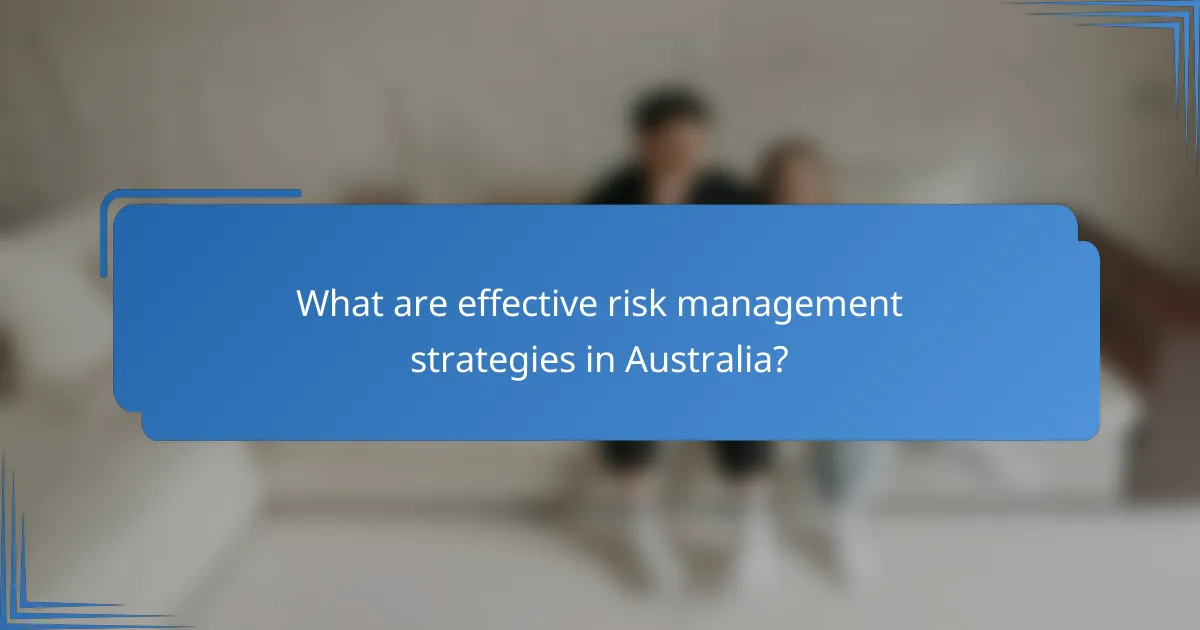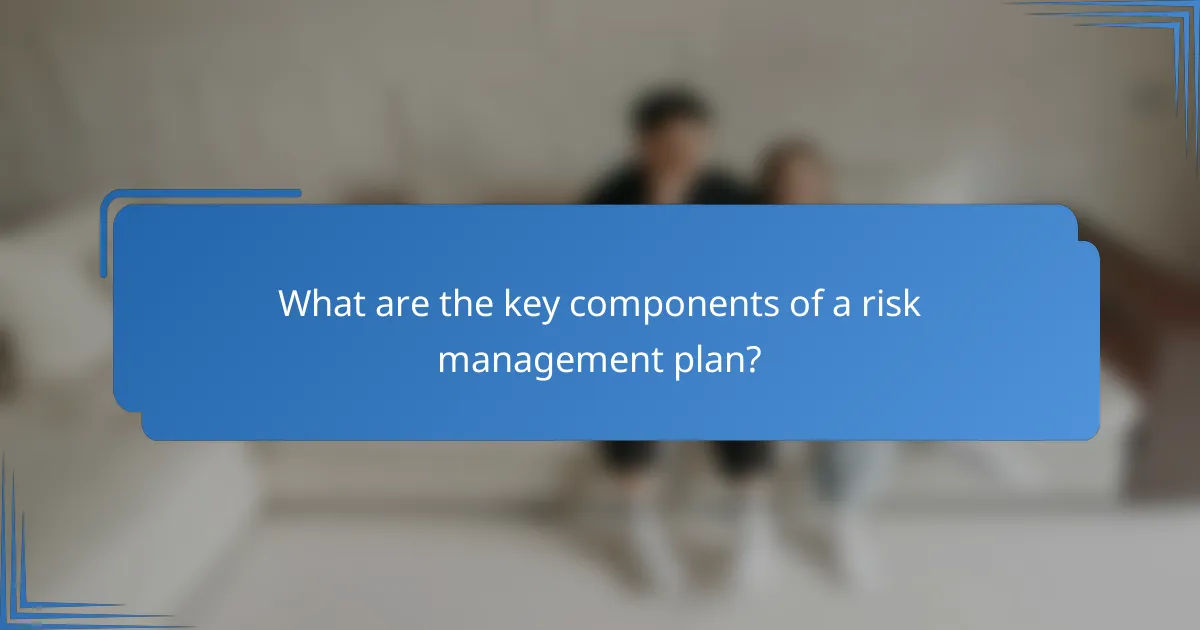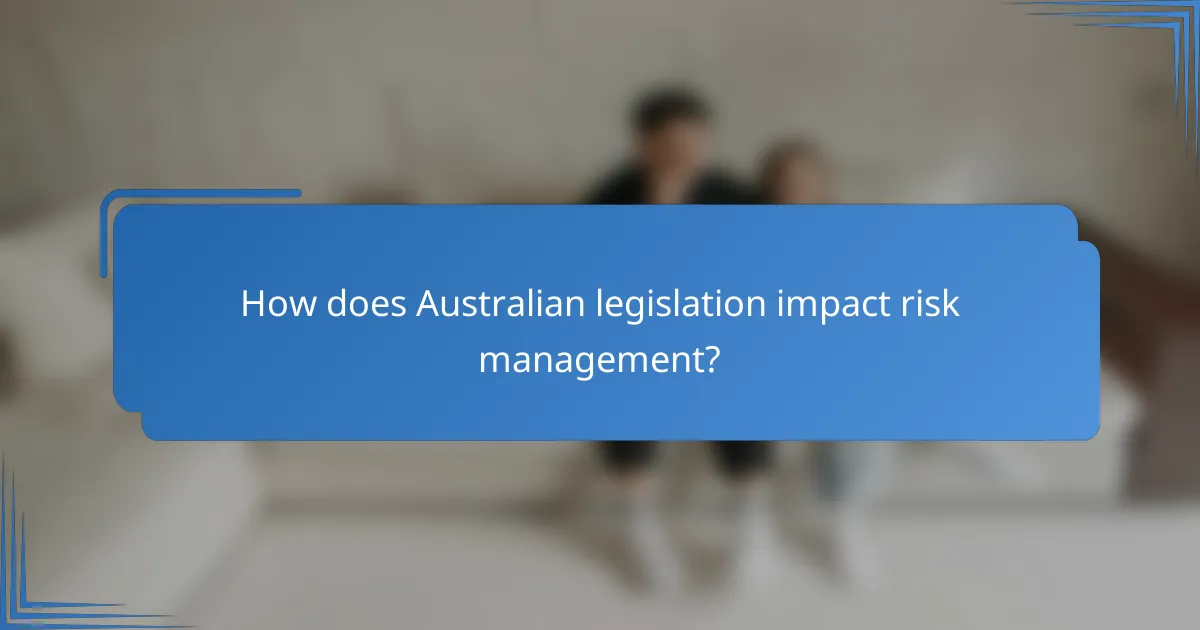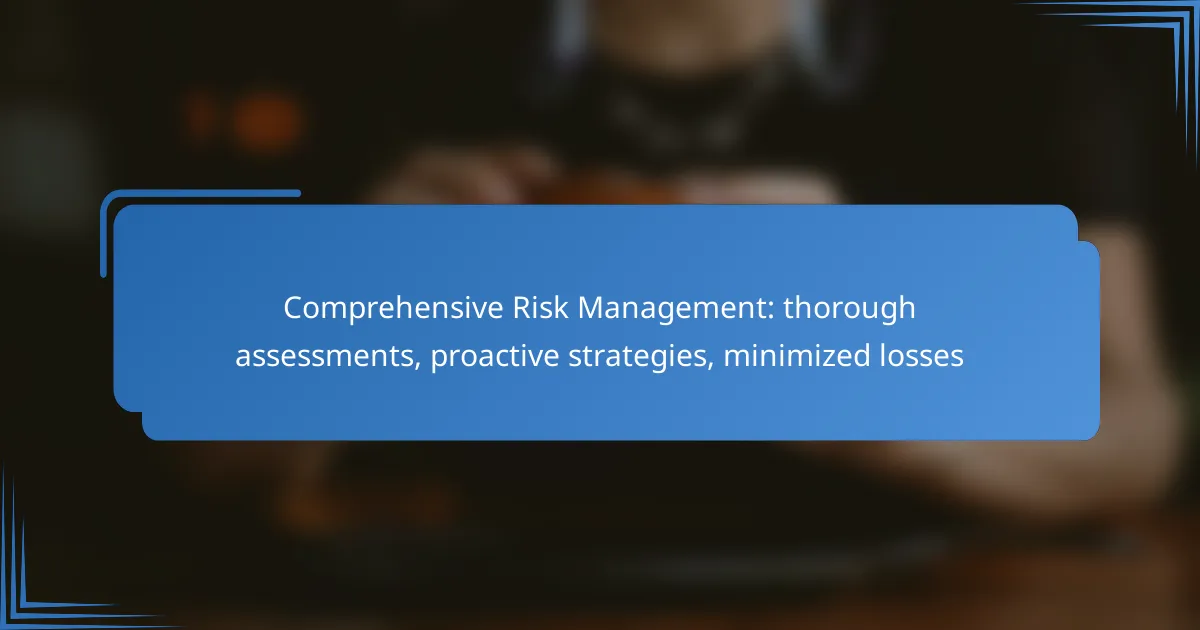Comprehensive risk management involves thorough assessments and proactive strategies designed to minimize potential losses for businesses. By identifying and addressing risks before they escalate, organizations can enhance their financial stability and operational efficiency. Utilizing various tools further streamlines the risk management process, enabling better decision-making and safeguarding assets against uncertainties.

What are effective risk management strategies in Australia?
Effective risk management strategies in Australia focus on thorough assessments, proactive measures, and minimizing potential losses. By implementing these strategies, businesses can better navigate uncertainties and protect their assets.
Proactive risk assessments
Proactive risk assessments involve identifying potential risks before they escalate into significant issues. This process includes regularly evaluating internal operations, external market conditions, and regulatory changes that could impact the business.
Utilizing tools such as SWOT analysis (Strengths, Weaknesses, Opportunities, Threats) can help organizations pinpoint vulnerabilities. Regularly updating these assessments ensures that new risks are addressed promptly, allowing for timely interventions.
Insurance coverage options
Choosing the right insurance coverage is crucial for mitigating financial losses from unforeseen events. In Australia, businesses should consider various policies, including public liability, professional indemnity, and property insurance, tailored to their specific needs.
It’s advisable to review insurance policies annually to ensure they align with current business activities and risks. Engaging with an insurance broker can provide insights into the most relevant coverage options available in the Australian market.
Compliance with Australian regulations
Compliance with Australian regulations is essential for effective risk management. Businesses must adhere to laws such as the Corporations Act and the Australian Consumer Law, which govern corporate conduct and consumer rights.
Regular training and updates on regulatory changes can help organizations maintain compliance. Implementing a compliance management system can streamline processes and reduce the risk of legal penalties or reputational damage.

How can businesses minimize losses?
Businesses can minimize losses by implementing proactive strategies that address potential risks before they escalate. This involves thorough assessments, contingency planning, and ongoing evaluations to ensure financial stability and operational efficiency.
Implementing contingency plans
Contingency plans are essential for minimizing losses as they prepare businesses for unexpected events. These plans should outline specific actions to take in various scenarios, such as natural disasters, supply chain disruptions, or sudden market changes.
To create effective contingency plans, businesses should conduct risk assessments to identify vulnerabilities and prioritize potential threats. Regularly reviewing and updating these plans ensures they remain relevant and effective in mitigating risks.
Regular financial audits
Conducting regular financial audits helps businesses identify discrepancies, inefficiencies, and areas of potential loss. These audits should be performed at least annually, but more frequent reviews can provide deeper insights into financial health.
During audits, businesses should analyze cash flow, expenses, and revenue streams. This allows for timely adjustments to budgets and financial strategies, ultimately reducing the risk of significant losses.
Employee training programs
Investing in employee training programs is crucial for minimizing losses related to human error and operational inefficiencies. Training should focus on risk awareness, compliance with regulations, and best practices in their respective roles.
Regular training sessions can enhance employee skills and knowledge, leading to better decision-making and a proactive approach to risk management. Consider implementing simulations or role-playing exercises to reinforce learning and prepare employees for real-world scenarios.

What tools assist in risk management?
Various tools play a crucial role in effective risk management by enabling organizations to identify, assess, and mitigate potential risks. These tools streamline processes, enhance decision-making, and ultimately minimize losses.
Risk assessment software
Risk assessment software helps organizations systematically identify and evaluate risks associated with projects or operations. These tools often include features for scoring risks based on likelihood and impact, allowing teams to prioritize their responses effectively.
When selecting risk assessment software, consider user-friendliness, integration capabilities with existing systems, and compliance with industry standards. Popular options include RiskWatch and LogicManager, which offer customizable templates and reporting features.
Project management tools
Project management tools facilitate the planning and execution of projects while incorporating risk management features. These tools, such as Asana or Trello, allow teams to track tasks, deadlines, and potential risks in a centralized platform.
Utilizing project management tools effectively involves setting up risk registers and assigning responsibilities for monitoring risks. Regular updates and team communication are essential to ensure that risks are managed proactively throughout the project lifecycle.
Data analytics platforms
Data analytics platforms provide insights into risk factors by analyzing large datasets to identify trends and patterns. Tools like Tableau and Microsoft Power BI enable organizations to visualize data, making it easier to spot potential risks before they escalate.
To maximize the benefits of data analytics in risk management, ensure that data sources are reliable and relevant. Regularly review analytics reports to stay informed about emerging risks and adjust strategies accordingly.

What are the key components of a risk management plan?
A risk management plan includes several essential components that help organizations identify, assess, and respond to potential risks. Key elements include risk identification, risk analysis, and risk response strategies, all aimed at minimizing losses and ensuring operational continuity.
Risk identification methods
Risk identification methods involve systematically recognizing potential risks that could impact an organization. Common techniques include brainstorming sessions, expert interviews, and checklists that focus on historical data and industry standards.
Another effective approach is conducting workshops that engage various stakeholders, allowing for diverse perspectives on potential risks. Utilizing tools like SWOT analysis (Strengths, Weaknesses, Opportunities, Threats) can also help in pinpointing risks across different areas of the organization.
Risk analysis techniques
Risk analysis techniques assess the likelihood and impact of identified risks. Qualitative analysis often involves categorizing risks based on their severity and probability, while quantitative analysis uses numerical data to estimate potential losses.
Common methods include risk matrices, which visually represent risks based on their likelihood and impact, and Monte Carlo simulations, which model the probability of different outcomes. Organizations should choose techniques that align with their specific context and available data.
Risk response strategies
Risk response strategies outline how to address identified risks effectively. These strategies typically fall into four categories: avoidance, mitigation, transfer, and acceptance. For instance, avoiding a risk might involve changing a project plan to eliminate the risk entirely.
Mitigation strategies aim to reduce the impact or likelihood of a risk, such as implementing safety protocols. Transferring risk can involve outsourcing certain functions or purchasing insurance, while acceptance means acknowledging the risk and preparing to deal with its consequences if it occurs.

How does Australian legislation impact risk management?
Australian legislation significantly influences risk management practices by establishing frameworks that organizations must follow to ensure compliance and minimize liabilities. Key laws such as the Work Health and Safety Act, the Corporations Act, and the Privacy Act provide guidelines that shape how risks are assessed and managed in various sectors.
Work Health and Safety Act
The Work Health and Safety (WHS) Act mandates that employers ensure the health and safety of their workers, which directly impacts risk management strategies. Organizations must identify potential hazards, assess risks, and implement control measures to mitigate them.
To comply with the WHS Act, businesses should conduct regular risk assessments and maintain clear documentation of safety procedures. Failure to comply can lead to significant penalties and increased liability, making proactive risk management essential.
Corporations Act compliance
The Corporations Act requires companies to manage risks related to corporate governance and financial reporting. This legislation emphasizes the importance of internal controls and risk management frameworks to protect shareholders and maintain market integrity.
Organizations should establish a risk management plan that aligns with the Corporations Act, including regular audits and reviews of financial practices. This not only ensures compliance but also enhances overall organizational resilience against financial risks.
Privacy Act considerations
The Privacy Act governs how personal information is handled, which is crucial for risk management in organizations that collect and process data. Companies must implement measures to protect personal data from breaches and unauthorized access.
To comply with the Privacy Act, businesses should conduct privacy impact assessments and develop clear data handling policies. Regular training for employees on data protection practices is also vital to minimize risks associated with data privacy violations.

What are emerging trends in risk management?
Emerging trends in risk management focus on integrating advanced technologies and proactive strategies to enhance assessments and minimize losses. Organizations are increasingly adopting data analytics, artificial intelligence, and holistic approaches to identify and mitigate risks effectively.
Integration of Technology
The integration of technology in risk management is transforming how organizations assess and manage risks. Tools like artificial intelligence and machine learning enable real-time data analysis, allowing for quicker identification of potential threats. This shift helps organizations adapt their strategies based on current data rather than relying solely on historical trends.
For example, financial institutions are using predictive analytics to forecast market fluctuations and adjust their risk profiles accordingly. This proactive approach can significantly reduce potential losses by enabling timely interventions.
Focus on Cybersecurity
With the rise of digital operations, cybersecurity has become a critical focus in risk management. Organizations are prioritizing the protection of sensitive data and infrastructure against cyber threats. This includes implementing robust security protocols and conducting regular vulnerability assessments.
Investing in cybersecurity measures can be costly, but the potential losses from data breaches can far exceed these expenses. Companies are encouraged to adopt a layered security strategy, combining technology, employee training, and incident response plans to mitigate risks effectively.
Regulatory Compliance
Regulatory compliance remains a significant aspect of risk management, especially in industries like finance and healthcare. Organizations must stay updated on changing regulations to avoid penalties and reputational damage. This requires regular audits and a thorough understanding of relevant laws and standards.
For instance, companies operating in the European Union must comply with the General Data Protection Regulation (GDPR), which mandates strict data handling practices. Non-compliance can result in hefty fines, making it essential for businesses to integrate compliance into their risk management frameworks.
Holistic Risk Management Approaches
Holistic risk management approaches consider the interconnectedness of various risks across an organization. This perspective encourages businesses to evaluate risks not in isolation but as part of a broader system. By doing so, organizations can identify potential cascading effects and develop comprehensive strategies to address them.
For example, a manufacturing company might assess risks related to supply chain disruptions, production delays, and market demand fluctuations simultaneously. This integrated approach allows for more effective contingency planning and resource allocation.
